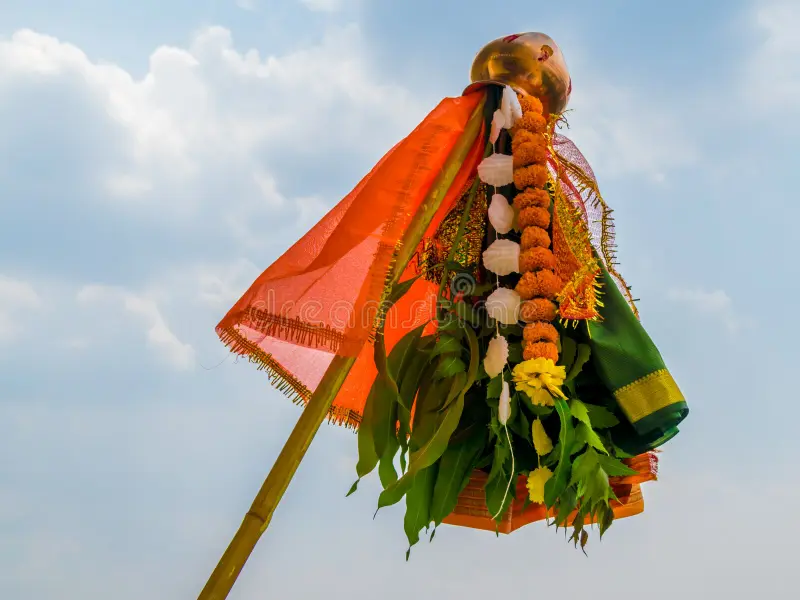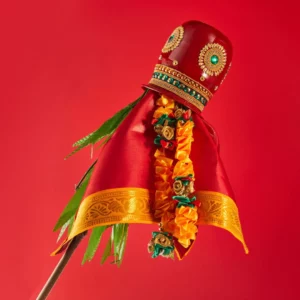🌼 Gudi Padwa(Guri parwa) 🌼

॥ ॐ श्री परमात्मने नमः ॥
🚩Gudi Padwa 2025 🚩

About Gudi Padwa:
The Hindu calendar’s Marathi New Year is marked by the well-known Indian event known as Gudi Padwa. Gudi Padwa is observed on the first day of Chaitra Shuddha Padyami, which is the first day (Pratipada tithi) of Shukla paksha in the month of Chaitra according to the Hindu lunisolar calendar. The term Pratipada is the root of the word “Padwa.” The term ‘starting with Chaitra’ (chaitra-aadi) refers to a calendar system that observes the Hindu month of Chaitra as the start of a new year.
***
🕰️Gudi Padwa 2025 Date & Time:📅
Marathi Shaka Samvata 1947 Begins
Gudi Padwa – Sunday, March 30, 2025.
Pratipada Tithi Begins—16:27 on Mar 29, 2025.
Pratipada Tithi Ends—12:49 on Mar 30, 2025.
***
🔰Significance Of Gudi Padwa festival:🔰
One of India’s most significant harvest seasons is Gudi Padwa. Gudi Padwa is a sign of the start of Kharif since it signifies the conclusion of the Rabi season. During this time of year, the Sun is in the first zodiac sign, Aries. On this day in mythology, Lord Brahma created the universe. This day also marks the start of the nine-day Chaitra Navratri celebrations.
A ‘gudi’ represents triumph. A ‘gudhi’ was raised as a symbol of victory by Chhatrapati Shivaji and his troops after defeating foreign infiltrators, according to Marathi history.
According to the Brahma Purana, the tale of Gudi is related to the ‘flag’ of Lord Brahma, which was set in place after the creation of the world. ‘Gudi’ is also linked to the return of happiness in numerous historical stories, such as when Lord Rama returned to his kingdom after fourteen years of exile.
***
🍀 Gudi Padwa Puja Vidhi:🍀
Many Hindus consider the festival sacred, and therefore they must meticulously follow the Puja Vidhi for this festival. We have listed the puja preparations down below. Let us see:
- Begin the puja preparations after taking a bath.
- Make a toran with mango leaves.
- Decorate the front entrance of the house with a rangoli made out of flowers and colors.
- Clean and decorate the temple inside your house.
- Light an oil lamp next to it.
- Assemble the Gudi by taking a bamboo stick and covering it with a clean cloth.
- Tie neem leaves and Saakhar gaathi around it.
- Decorate it with flowers and mango leaves.
- Invert a pot or Kalash and put it next to the stick.
- Put kumkum, haldi, and akshat on the Gudi.
- Make offerings of fruits, flowers, paan, supari, incense sticks, and dhoop to the deities.
- Offer the naivedhyam prepared to the gods and goddesses and seek their blessings for a happy and prosperous life.
- Hoist the flag outside the entrance of the house after the puja is complete.
- Perform aarti in the temple as well as of the gudi.
- Unfurl the flag before sunset time.
***
The Myth Behind Gudi Padwa
Many myths and legends mention Gudi Padwa. One of the holiest Hindu texts, the Brahma Purana, states that after a catastrophic disaster killed everyone and halted time, Lord Brahma restored the world. This day marked the beginning of the era of justice and truth as time began anew as a result of Brahma’s efforts. On this day, people honor Lord Brahma as a result.
According to another legend, after 14 years of exile, Lord Rama brought Sita and Laxman back to Ayodhya. The triumph of Lord Rama over Ravana is celebrated on this day. As a result, Gudi, or Brahma’s flag, is raised in homes in the same manner that it was raised in Ayodhya as a victory flag (according to the legend) following Rama’s triumph over Ravana.
But Gudi has additional historical value. History tells us that Chhatrapati Shivaji Maharaj overthrew the Mughals and liberated the state’s citizens from their domination. This is one of the main explanations for why Maharashtra residents celebrate Gudi on this day. It is thought that the flag keeps evil spirits out of homes and businesses.
***
💐How is Gudi Padwa Celebrated?💐
People clean their homes and courtyards to keep everything spotless as the celebration mainly commemorates the start of a new year. On this day, a traditional oil bath is required. Women use “Rangolis” in a variety of colors and patterns to adorn the entry doors. An essential component of the tradition is dressing in new clothing, particularly sarees and kurta-pajamas.
The hoisting of Gudi is arguably the festival’s most significant event.In order to reach the Gudi and shatter the coconut inside, individuals climb into a human pyramid once they raise it. They observe a significant festival rite practically all over Maharashtra.Participation in this ceremony is restricted to men and teenage boys.
Eating neem leaves, a tradition that signifies the start of the festival, is another rite. You can consume the leaves fresh or ground and combine them with jaggery and other seeds to make a chutney. Shrikhand, a dessert eaten with Poori, Pooran Poli, Chana, and Soonth Panak, is another food made on this day.
Therefore, if you are in Maharashtra, you can also participate in this celebration. On this day, people cook several traditional foods, particularly desserts. In some regions of India, they also observe the festival as Poila Boishakh (West Bengal), Bihu (Assam), and Ugadi (Karnataka, Andhra Pradesh, and Telangana).
🌻Interesting Facts About Gudi Padwa:🌻
Rangoli is an important part of Gudi Padwa, and when people celebrate with great fervor, they crowd the streets with these Rangolis.
During the parade commemorating Gudi Padwa, or the start of the new year, people in western Maharashtra dress traditionally and dance.
To celebrate the rich culture and heritage of the area, women swarm the streets in bright, colorful clothing.
Since Lord Rama defeated Ravan and returned to Ayodhya, the celebration also symbolizes the triumph of good over evil.
In celebration of Gudi Padwa, sweets like shrikhand, puri, and puran poli are prepared and shared. Kanangachi kheer, an Indian sweet dessert cooked with sweet potatoes, rice, coconut milk, and jaggery, is one of the dishes that Konkanis make.
***
🍀Gudi Padwa Wishes in Marathi:🍀
नववर्षाच्या हार्दिक शुभेच्छा!
(Happy New Year!)
गुडीपाडव्याच्या शुभेच्छा!
(Happy Gudi Padwa)
गुडीपाडवा तुम्हाला आणि तुमच्या कुटुंबाला आनंद, समृद्धी आणि यश आणो!
(May Gudi Padwa bring you and your family happiness, prosperity, and success!)
या नववर्षात तुम्हाला तुमच्या सर्व इच्छा पूर्ण व्हाव्या!
(May all your wishes come true in this New Year!)
नववर्षाच्या शुभेच्छा!
(Happy New Year!)
***
💐Conclusion 💐
Gudi Padwa is a celebration of tradition, solidarity, and the never-ending cycle of rebirth rather than merely a festival. Let’s celebrate the enduring customs and ideals that this auspicious occasion embodies as we joyfully and enthusiastically greet the start of another year. Through customary practices, contemporary interpretations, or educational initiatives, Gudi Padwa never fails to uplift and bring people together while bringing hope for future success and joy.
***